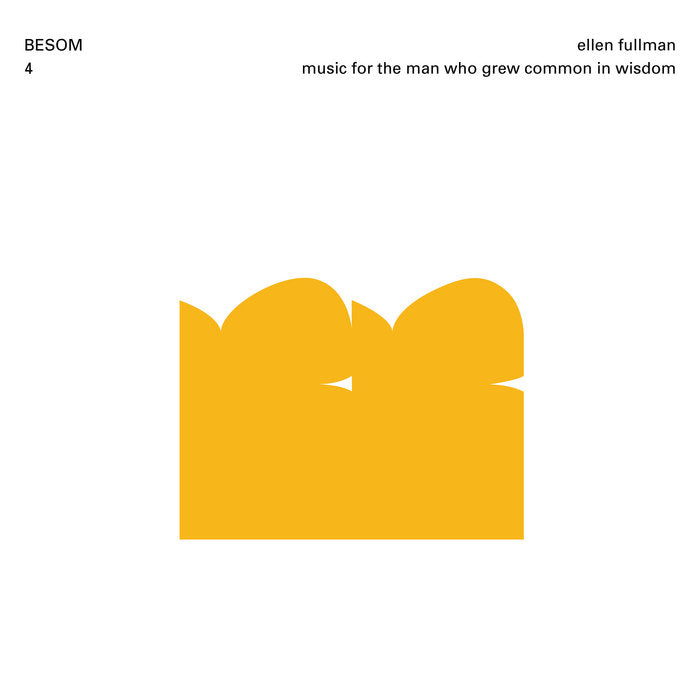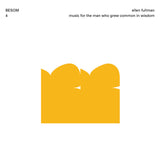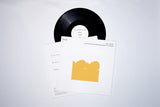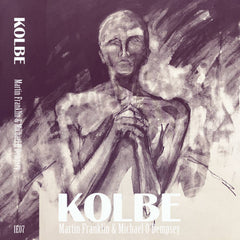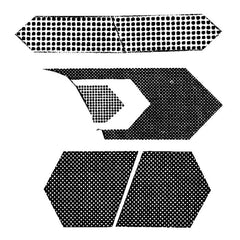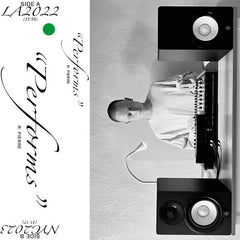ellen fullman // music for the man who grew common in wisdom LP
- Availability:
American experimental musician ellen fullman will launch an experimental/drone label in Los Angeles in 2020.A record released on Besom Presse.
using long wiresworksShe is famous for , but this work includes two songs created for theatrical performances using glass, wood chips, water, etc. DL code included.
Below is a commentary by the label.
"The besom presse presents ellen fullman's Music for the Man Who Grew Common in Wisdom. Ellen Fullman, known for his sculptural long string instruments (LSI), is a work of musique concrète. showcases a lesser-known side of ellen fullman's sonic exploration.In two sprawling works, ellen fullman moves between the comical, the menacing and the blissful. Traveling and evoking a unique kinetic and tonal aesthetic for which she is widely admired, the music was originally composed by choreographer Deborah Hay from 2 to 1987 while she lived in Austin, Texas. Used as an accompaniment to a dance piece, the release on besom presse contains the last two movements of all songs.
In 1985, Hay, a founding member of the Judson Dance Theater, asked Ellen Fullman to co-produce a new production.Hay was deeply influenced by his experience as a member of the Merce Cunningham Dance Company and the way John Cage and Cunningham collaborated.As such, timing was the only pre-determined relationship between Ellen Fullman's music and choreography.Inspired by Hay's freewheeling approach and encouraged to use new musical instruments, ellen fullman explained: "I was free to explore my own fascination with the absurd knowing that I wouldn't be criticized." Pursuing possibilities.Describing her experience with the tool, she explains: "I was fascinated by what I could do with Prophet and started working in a way that evolved from the Musik Concrète approach I had previously used with reel-to-reel tape recorders. did.
One of the most interesting contextual aspects of this work is the fluid circumstances in which it was made. After devoting much time and energy to deepening his knowledge of LSI, recently relocated and using unfamiliar gear, this record offers a rare snapshot of ellen fullman's composing journey. there is
This excursion can be listened to repeatedly.The musical events come naturally, maintaining a rare balance between the poetic and the apathetic.It's time-stamped by its technology, but it's not old-fashioned to embarrass many of the past's more radical releases. The A-side, entitled "Music for the Gardener," features shards of glass dropped on concrete slabs, the gentle sound of hanging wood chips, water tumbling back and forth, and her own It is triggered by a number of exquisitely recorded sounds from various common sources such as voices.Starting with chromatically arranged glass, ellen fullman playfully improvises, triggering individual notes from a series of chord shapes.Chimes and bounces are punctuated by sudden cluster chords, like six-packs stuck in a brick wall.This gives a generous sonic foil to the icy digital aliasing of glass samples.Focusing again, the sound of the water in the bathtub is played in high fidelity, and is heard in a dizzyingly wide stereo field with microphones placed on either side of the bathtub.Fruman's sampled voice plays a contemplative modal melody, implying a sort of coda underpinned by the rhythm of clanging trees.
Side B, "Music for the Aviator," is rooted in Deborah's directive.Like a soundtrack replacement for Jodorowsky's Santa Sangre, the starter gun, bubbles, cheers and calliope organ recall a lyrical day at the circus.More or less, sudden disturbances occur everywhere.The circus is engulfed in the sounds of cetacean blowholes, which sound like the Hindeu flute of Ba Benzere Pygmy music (think Herbie Hancock's Watermelon Man intro). fade out.Ultimately, the work erupts with a dense spectrum of overtones, while settling into a satisfying rhythmic pulse of attuned breaths nestled in a cloud of faint vocal loops.
The Man Who Grew Common In Wisdom was performed in August 2019 at the RE-Perspective Deborah Hay, Works from 8 to the Present at the Tanz im August Festival in Berlin.Eva Mohn of Stockholm's Kluberg Ballet was the soloist and the work became part of their repertoire. "
Labels and other worksplease use this form. ///Click here to see more besom press releases available at Tobira.
----------------------
Includes DL code. 12" black vinyl.
Tracklist:
- the gardener 17:48
- the aviator 22:10
besom presses:
"besom presse announces the release of Ellen Fullman's Music for the Man Who Grew Common in Wisdom. Known prominently for her sculptural Long String Instrument (LSI), these musique concrete pieces showcase an underrecognized side of Fullman's sound investigations. In two expansive works, Fullman voyages through the comic, the menacing and the blissful all while evoking the unique kinetic and timbral aesthetic for which she is widely praised. Composed between 1987-1989, while living in Austin, Texas, the music originally served as accompaniment to choreographer Deborah Hay's dance piece of the same name. The besom presse release presents the last two movements of the full composition.
In 1985, Hay, a founding member of the Judson Dance Theater, commissioned Fullman to collaborate on a new work. Such, the only relationship planned between Fullman's music and the choreography was timing. Inspired by Hay's open-ended approach and encouraged to use a new set of musical implements, Fullman explained, “I found this way of working to be remarkably refreshing and respectful of my process. I felt free to delve into my attraction for absurdity, knowing that I would not be judged.” With a variety of acoustic sound sources, Music for the Man Who Grew Common in Wisdom finds Fullman exploring the possibilities of the Prophet sampler. Describing her experience of using this tool she explains: “I was fascinated by what could be done with the Prophet and worked in a way that could be seen as an outgrowth from the musique concrete approach that I had used with a reel-to-reel tape recorder in earlier years.”
One of the most interesting contextual aspects of Music for the Man Who Grew Common in Wisdom is the flux under which it was created. Recently relocated and using unfamiliar equipment after having dedicated so much of her time and energy to her advancing knowledge of the LSI, This record provides an ultra-rare snapshot of Fullman's journey as a composer: a suspended moment while her earlier phase of sound collaging comes into direct contact with her sensibilities of movement and sound as refined by her work with the LSI.
The excursion rewards careful, repeated listening. Its musical events arrive spontaneously while striking a rare balance between the poetical and unaffected. While the work is time-stamped by its technology, it evades the quaintness that beleaguers so many novel releases from the past. side A, titled Music for the Gardener, Fullman triggers an assortment of exquisitely recorded acoustic sounds from a variety of quotidian sources including bits of glass dropped on a concrete slab, the gentle clanking of suspended woodscraps, water swishing back and forth, and her own The piece begins with the glass, arranged chromatically, which Fullman playfully improvises with by triggering individual notes from a series of chord shapes. The effervescent chime and bounce is punctuated with sudden cluster chords that explode like a six-pack against a brick wall This gives way to the round and muted tones of the swinging timber—a generous sonic foil to the icy digital aliasing of the glass samples. Shifting focus again, we hear the hi-fi swishing of water in a tub reproduced in a dazzlingly wide stereo field made possible by microphones arranged at either end of the bath. Fullman's sampled voice, played in a meditative modal melody, signifies a kind of coda anchored by the rhythmic pulsing of clanking wood.
Side B's Music for the Aviator is rooted in Deborah's directive: "We contain the mystery, but we don't know what it is." Like an alternative soundtrack to Jodorowsky's Santa Sangre, starter guns, percolating bubbles, cheering crowds, and a calliope organ conjure a lysergic day at the circus. More or less abrupt disturbances take place throughout. Hancock's Watermelon Man). Eventually the piece settles into a satisfying rhythmic pulse of tuned breath sounds set in a cloud of woozy voice loops while a tightly packed spectrum of overtones springs forth.
The Man Who Grew Common In Wisdom was performed in August 2019 at the Tanz im August Festival, Berlin, in their RE-Perspective Deborah Hay, Works from 1968 to the Present. Eva Mohn of the Cullberg Ballet, Stockholm, was the soloist, and the work has become part of their repertoire. Music from the first movement of this piece, The Navigator (aka “Staggered Stasis”), was made available earlier this year by Superior Viaduct on a reissue of Fullman's 1987 self-released cassette, In The Sea.
"
Artist: ellen fullman
Label : besom press
American experimental musician ellen fullman will launch an experimental/drone label in Los Angeles in 2020.A record released on Besom Presse.
using long wiresworksShe is famous for , but this work includes two songs created for theatrical performances using glass, wood chips, water, etc. DL code included.
Below is a commentary by the label.
"The besom presse presents ellen fullman's Music for the Man Who Grew Common in Wisdom. Ellen Fullman, known for his sculptural long string instruments (LSI), is a work of musique concrète. showcases a lesser-known side of ellen fullman's sonic exploration.In two sprawling works, ellen fullman moves between the comical, the menacing and the blissful. Traveling and evoking a unique kinetic and tonal aesthetic for which she is widely admired, the music was originally composed by choreographer Deborah Hay from 2 to 1987 while she lived in Austin, Texas. Used as an accompaniment to a dance piece, the release on besom presse contains the last two movements of all songs.
In 1985, Hay, a founding member of the Judson Dance Theater, asked Ellen Fullman to co-produce a new production.Hay was deeply influenced by his experience as a member of the Merce Cunningham Dance Company and the way John Cage and Cunningham collaborated.As such, timing was the only pre-determined relationship between Ellen Fullman's music and choreography.Inspired by Hay's freewheeling approach and encouraged to use new musical instruments, ellen fullman explained: "I was free to explore my own fascination with the absurd knowing that I wouldn't be criticized." Pursuing possibilities.Describing her experience with the tool, she explains: "I was fascinated by what I could do with Prophet and started working in a way that evolved from the Musik Concrète approach I had previously used with reel-to-reel tape recorders. did.
One of the most interesting contextual aspects of this work is the fluid circumstances in which it was made. After devoting much time and energy to deepening his knowledge of LSI, recently relocated and using unfamiliar gear, this record offers a rare snapshot of ellen fullman's composing journey. there is
This excursion can be listened to repeatedly.The musical events come naturally, maintaining a rare balance between the poetic and the apathetic.It's time-stamped by its technology, but it's not old-fashioned to embarrass many of the past's more radical releases. The A-side, entitled "Music for the Gardener," features shards of glass dropped on concrete slabs, the gentle sound of hanging wood chips, water tumbling back and forth, and her own It is triggered by a number of exquisitely recorded sounds from various common sources such as voices.Starting with chromatically arranged glass, ellen fullman playfully improvises, triggering individual notes from a series of chord shapes.Chimes and bounces are punctuated by sudden cluster chords, like six-packs stuck in a brick wall.This gives a generous sonic foil to the icy digital aliasing of glass samples.Focusing again, the sound of the water in the bathtub is played in high fidelity, and is heard in a dizzyingly wide stereo field with microphones placed on either side of the bathtub.Fruman's sampled voice plays a contemplative modal melody, implying a sort of coda underpinned by the rhythm of clanging trees.
Side B, "Music for the Aviator," is rooted in Deborah's directive.Like a soundtrack replacement for Jodorowsky's Santa Sangre, the starter gun, bubbles, cheers and calliope organ recall a lyrical day at the circus.More or less, sudden disturbances occur everywhere.The circus is engulfed in the sounds of cetacean blowholes, which sound like the Hindeu flute of Ba Benzere Pygmy music (think Herbie Hancock's Watermelon Man intro). fade out.Ultimately, the work erupts with a dense spectrum of overtones, while settling into a satisfying rhythmic pulse of attuned breaths nestled in a cloud of faint vocal loops.
The Man Who Grew Common In Wisdom was performed in August 2019 at the RE-Perspective Deborah Hay, Works from 8 to the Present at the Tanz im August Festival in Berlin.Eva Mohn of Stockholm's Kluberg Ballet was the soloist and the work became part of their repertoire. "
Labels and other worksplease use this form. ///Click here to see more besom press releases available at Tobira.
----------------------
Includes DL code. 12" black vinyl.
Tracklist:
- the gardener 17:48
- the aviator 22:10
besom presses:
"besom presse announces the release of Ellen Fullman's Music for the Man Who Grew Common in Wisdom. Known prominently for her sculptural Long String Instrument (LSI), these musique concrete pieces showcase an underrecognized side of Fullman's sound investigations. In two expansive works, Fullman voyages through the comic, the menacing and the blissful all while evoking the unique kinetic and timbral aesthetic for which she is widely praised. Composed between 1987-1989, while living in Austin, Texas, the music originally served as accompaniment to choreographer Deborah Hay's dance piece of the same name. The besom presse release presents the last two movements of the full composition.
In 1985, Hay, a founding member of the Judson Dance Theater, commissioned Fullman to collaborate on a new work. Such, the only relationship planned between Fullman's music and the choreography was timing. Inspired by Hay's open-ended approach and encouraged to use a new set of musical implements, Fullman explained, “I found this way of working to be remarkably refreshing and respectful of my process. I felt free to delve into my attraction for absurdity, knowing that I would not be judged.” With a variety of acoustic sound sources, Music for the Man Who Grew Common in Wisdom finds Fullman exploring the possibilities of the Prophet sampler. Describing her experience of using this tool she explains: “I was fascinated by what could be done with the Prophet and worked in a way that could be seen as an outgrowth from the musique concrete approach that I had used with a reel-to-reel tape recorder in earlier years.”
One of the most interesting contextual aspects of Music for the Man Who Grew Common in Wisdom is the flux under which it was created. Recently relocated and using unfamiliar equipment after having dedicated so much of her time and energy to her advancing knowledge of the LSI, This record provides an ultra-rare snapshot of Fullman's journey as a composer: a suspended moment while her earlier phase of sound collaging comes into direct contact with her sensibilities of movement and sound as refined by her work with the LSI.
The excursion rewards careful, repeated listening. Its musical events arrive spontaneously while striking a rare balance between the poetical and unaffected. While the work is time-stamped by its technology, it evades the quaintness that beleaguers so many novel releases from the past. side A, titled Music for the Gardener, Fullman triggers an assortment of exquisitely recorded acoustic sounds from a variety of quotidian sources including bits of glass dropped on a concrete slab, the gentle clanking of suspended woodscraps, water swishing back and forth, and her own The piece begins with the glass, arranged chromatically, which Fullman playfully improvises with by triggering individual notes from a series of chord shapes. The effervescent chime and bounce is punctuated with sudden cluster chords that explode like a six-pack against a brick wall This gives way to the round and muted tones of the swinging timber—a generous sonic foil to the icy digital aliasing of the glass samples. Shifting focus again, we hear the hi-fi swishing of water in a tub reproduced in a dazzlingly wide stereo field made possible by microphones arranged at either end of the bath. Fullman's sampled voice, played in a meditative modal melody, signifies a kind of coda anchored by the rhythmic pulsing of clanking wood.
Side B's Music for the Aviator is rooted in Deborah's directive: "We contain the mystery, but we don't know what it is." Like an alternative soundtrack to Jodorowsky's Santa Sangre, starter guns, percolating bubbles, cheering crowds, and a calliope organ conjure a lysergic day at the circus. More or less abrupt disturbances take place throughout. Hancock's Watermelon Man). Eventually the piece settles into a satisfying rhythmic pulse of tuned breath sounds set in a cloud of woozy voice loops while a tightly packed spectrum of overtones springs forth.
The Man Who Grew Common In Wisdom was performed in August 2019 at the Tanz im August Festival, Berlin, in their RE-Perspective Deborah Hay, Works from 1968 to the Present. Eva Mohn of the Cullberg Ballet, Stockholm, was the soloist, and the work has become part of their repertoire. Music from the first movement of this piece, The Navigator (aka “Staggered Stasis”), was made available earlier this year by Superior Viaduct on a reissue of Fullman's 1987 self-released cassette, In The Sea.
"
Artist: ellen fullman
Label : besom press

